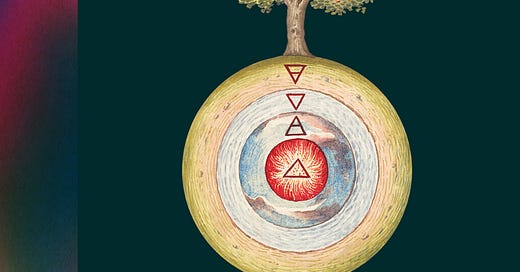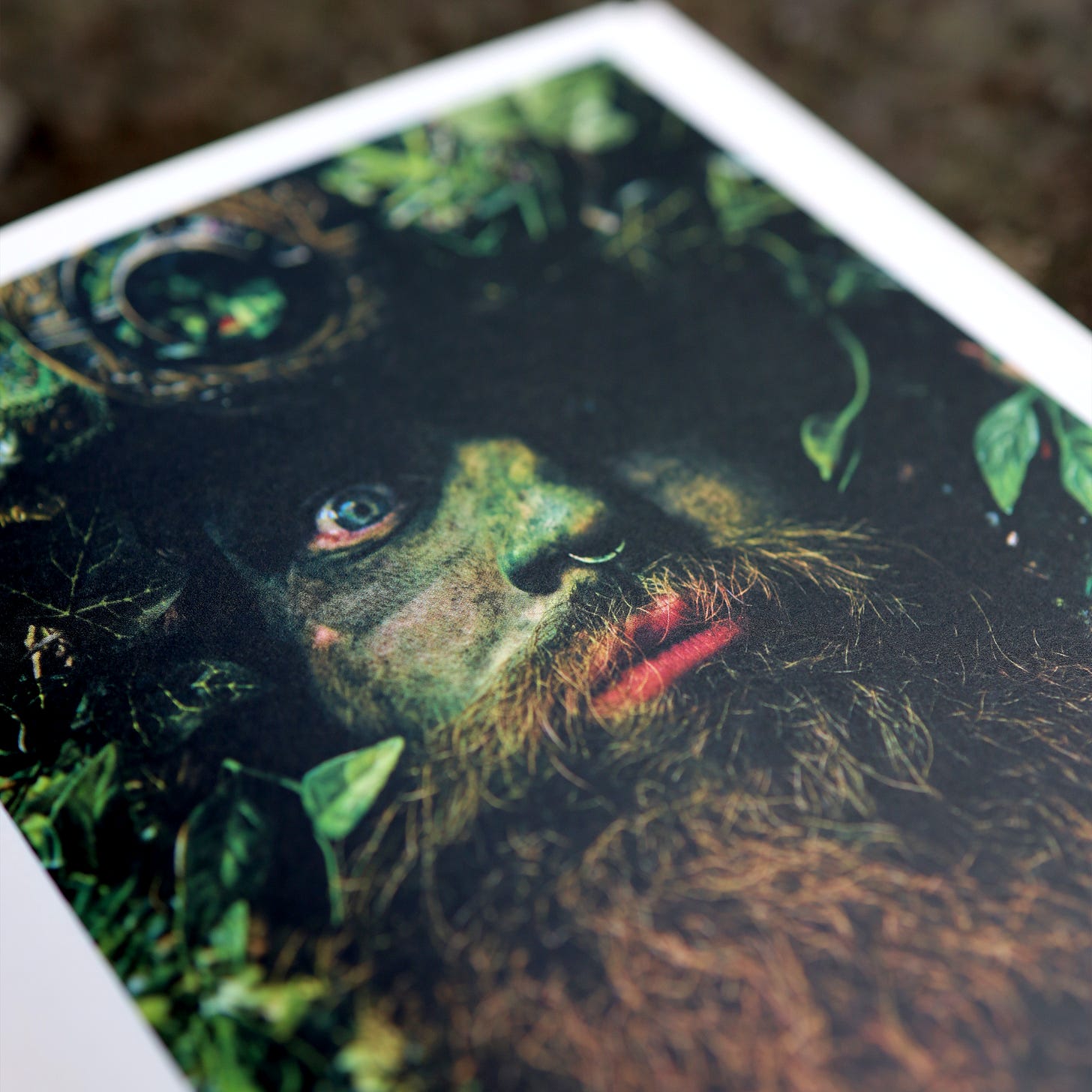Stephen Ellcock is known to many as an alchemical curator of remarkable visuals. Initially garnering a reputation for unearthing and presenting forgotten, and often deeply symbolic, images online, Stephen’s goal of creating ‘the ultimate social media Cabinet of Curiosities’ has evolved into working with publishers to explore his collections in print.
Inspired by physician and occultist Robert Fludd’s presentation of the order of the elements, Stephen’s latest book explores chaos, order and the five elemental forces, and it’s available now in the WEIRD WALK BOOK CULT shop. We discussed Stephen’s process and why an ancient idea has so much relevance today.
Many people are familiar in passing with the idea of the elements, but they perhaps seem removed from common ways of thinking about the world today. What appealed to you about this ancient classification of matter and forces?
In the pre-modern world the theory of the five classic elements of air, fire, earth, water, and aether (aka ‘quintessence’, aka ‘spirit’) provided ingenious, elegant answers to the most fundamental questions of existence: where did we come from and of what are we made? How did the world around us and the world above us come to be, and of what are they made? Why do things change and why does nothing last?
The theory of the elements helped explain the complexity of nature and of matter, capturing the ineffable and inexplicable by breaking everything down into simpler constituent parts.
The classic elements are also the foundation of our sensory experience of the world and function as powerful metaphors and profound representations of psychological states, archetypal symbols common to almost all religious and mythological traditions, ritual, magic, science, art, storytelling and dreams; ever-evolving symbols of powerful, terrifying forces and ever-present in both high – and low – culture, from the Four Quartets to the Fantastic Four (™).
You have a huge following online for your image curation. How does the work with publishers differ to your online collections?
Compiling books and working with publishers definitely requires a different mindset and more disciplined approach to posting online.
The most significant difference and one of the key considerations when selecting images for books is the whole issue of image rights, permissions, copyright etc. Picture rights can be eye-wateringly expensive and securing rights and negotiating fees can be exasperating and time-consuming.
Thankfully, many artists, creators, galleries, museums and institutions are incredibly generous, obliging and considerate, and I am also now incredibly fortunate that my publisher (Thames & Hudson) employs a team of incredibly talented, creative and remarkably patient people who are experts at navigating this particular minefield.
I am, however, required to be incredibly meticulous and resourceful when it comes to picture research for my books. Working on such lavishly illustrated books whilst being ever mindful of budgets and financial constraints means that I do try and find as many images that are in the public domain, and therefore free to use, as possible.
Ironically, these limitations can often prove incredibly rewarding and productive. Sometimes, when I have been forced to rely on my wits with limited resources or need to find an image very quickly, I can often find the most amazing, fitting and perfect treasures in the most unpromising, unlikely places.
A key theme running throughout the book is the interrelation of all things. We were really struck, for example, by the way music is represented in a Theosophical text on one page, and then opposite there is a view of a spiral galaxy from NASA, and they work perfectly together. How important was it to find these connections and affinities when compiling the images for each element and laying out the book?
If I were to attempt to summarise everything I have been doing over the past decade and a half, starting with all the years of compulsive messing around and posting obsessively on social media then, more recently, with the books I have been compiling, I would have to say that it is an ongoing attempt to capture and highlight the interrelationship of all things. Uncovering and revealing surprising and startling connections, affinities and correspondences between different cultures, disciplines, media, traditions and timeframes is key to everything that I do.
I spend countless hours deliberating and agonizing over the sequencing, layout and juxtaposition of images in my books (and on Instagram too, now I come to think of it). I take enormous pleasure from the art of pattern making, creating diptychs and collages from completely unrelated source material. When compiling and planning the design of my books, my principal aim is to create a dialogue between the images, thereby revealing fresh perspectives, exposing tensions and unearthing hidden meanings, significance and possibilities. This act of synthesis, an attempt to create something new by combining, arranging and rearranging freely available material, is definitely the most rewarding part of the editing process.
The promise of a truly democratic, egalitarian, open-source internet may be receding rapidly, but I do believe that the technological revolutions of recent decades can still provide the opportunity and necessary resources to create an ever-expanding Infinite Archive, a universe-spanning cabinet of wonders, a visual encyclopedia of ‘Everything’ (multiple impending apocalyptic scenarios permitting, of course).
Was there an element that you particularly enjoyed working on and researching? Were some more challenging than others to represent?
I could (and would love to) produce multiple volumes devoted to ‘Fire’ and ‘Water’. ‘Aether’ was a bastard and extremely problematic until I forced myself to think outside the ‘Spirit Box’, and now I think it may possibly be my favourite chapter.
‘Aether’ is definitely the least familiar, most elusive and ineffable of the classic elements, but I hope that the preternatural beauty, mystery and ambiguity of the images I have chosen will appeal on a purely aesthetic and emotional level, whilst encouraging and inviting further research.
One joy of the book is discovering so much human ingenuity in representations of the natural world and its forces. In the time of AI and climate breakdown, a reminder of human agency and connection to nature seems particularly welcome. Where did you sense contemporary parallels and relevance in the works you collected for the book, some of which are hundreds, or even thousands, of years old?
It seems obvious to me that the greatest art and the greatest achievements of humankind in any time, in any place, in any situation are always attempts at finding balance, equilibrium, peace, fulfilment and a place in Space and Time. The greatest achievements and most beneficial advances in every sphere of human activity (art, science, philosophy, medicine, agriculture, social structures etc) have always had, at their core, a recognition of the mutual interrelation of all things and all beings. The five classic elements symbolise this interrelationship of all things, the violent, unpredictable forces holding everything together, binding the material with the immaterial, the known with the unknown. This book is an attempt to highlight the interdependency that is a vital component of any functioning ecosystem.
By featuring images drawn from vastly disparate sources and traditions I hope to drive home the fact that this struggle to achieve balance and equilibrium and make peace with the Universe and the implacable forces of nature is eternal, ongoing and never futile.
If we are to confront and overcome the multiple crises before us and escape the pitfalls and quagmires of modern life, then we need to be brutally honest with ourselves and with each other, reengage with the planet on a daily basis and jealously guard any hope we can muster in the face of stomach-churning odds.








I just bought this last weekend at The Welcome Collection down in London. Really looking forward to reading it.
I've had my eye on this book for a little while now, but after reading this, it's definitely going on my Christmas list!